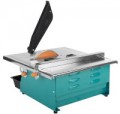Power
Rated motor power of the electric tile cutter. The more powerful the engine — the more force it can give to the cutting tool, the higher the rotation speed and disc diameter can be. Accordingly, a more
powerful tool is better suited for larger jobs and hard and/or thick materials. On the other hand, high power significantly affects the price, dimensions and weight of the tool, despite the fact that there is not always a real need for it.
In light of all this, it is necessary to choose a tile cutter in terms of power, taking into account the specifics of the intended use. So, in the case of a hand tool for simple household work, a power of 700 – 800 W is enough, more solid indicators may be required mainly for professional use. But in stationary units, where compactness does not really matter, you can not save on power — especially since such devices are usually used where performance is important.
Rotation speed
The maximum disc rotation speed provided by the motor of the electric tile cutter. Higher speeds are good for productivity, clean cuts and the ability to handle difficult materials, but they also require the right amount of power.
In general, if a tile cutter is bought for simple work with ordinary facing tiles (for example, repairs in an apartment), you can not pay much attention to this indicator: even the “slowest” models provide enough speed to cope with such tasks. But for cutting specific materials (for example, some types of stone), higher speeds may be required; detailed recommendations on this issue can be found in special sources.
Cutting depth
The greatest depth to which the tool can cut through the material being processed, in other words, the maximum thickness of the tile that the tile cutter is guaranteed to be able to cut.
It is worth choosing a tool for this parameter taking into account the thickness of the material with which to work, plus some margin “just in case”. But this margin should not be too large: for a
deep cut, large discs and high power are required, which accordingly affects the price, weight and dimensions of the tool.
Angle stop
The presence of an angular stop in the design of the tile cutter.
The miter fence is designed to make it easier to cut diagonals and other oblique lines. Do not confuse this function with angular cutting: in this case, we are talking about turning the material horizontally, and the cut itself can be normal, vertical. The corner stop is convenient because you can set it to the desired angle in advance, and then fix the tile in it and not worry about it moving during cutting. This is easier than holding the material by hand and controlling the angle in other ways.
Table dimensions
The size of the working surface of the stationary tile cutter (see "Type"). The larger the table, the lower the likelihood that the tiles will hang from it during operation.

